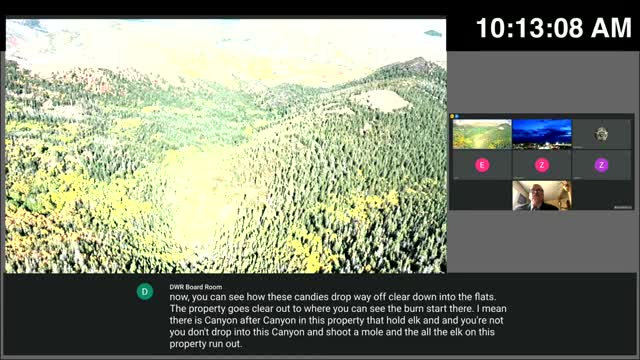Elk Habitat Crisis Sparks Urgent Call for Conservation Action
August 22, 2024 | Utah Department of Natural Resources, Utah Government Divisions, Utah Legislative Branch, Utah
This article was created by AI summarizing key points discussed. AI makes mistakes, so for full details and context, please refer to the video of the full meeting. Please report any errors so we can fix them. Report an error »

In a recent government meeting, discussions centered around the management and conservation of elk habitats in a region significantly impacted by an 18,000-acre wildfire. The fire has left vast areas devoid of vegetation, prompting concerns about the future of local wildlife, particularly elk, which rely on specific habitats for survival.
A key speaker highlighted the unique characteristics of the property in question, emphasizing its role as a critical refuge for elk during the hunting season. The speaker noted that the area contains 80% of the water sources on the mountain, which are essential for elk, as studies indicate that these animals typically do not venture more than half a mile from water. The terrain, characterized by steep ridges, also serves as a natural barrier, preventing elk from migrating far from their established habitats.
The conversation also touched on the importance of partnerships between private landowners and the Department of Wildlife Resources (DWR) to enhance habitat conservation efforts. The speaker expressed frustration over the challenges faced in garnering support for a Cooperative Wildlife Management Unit (CWMU) that would facilitate such partnerships. Despite previous setbacks in securing votes from regional advisory councils, the speaker remains optimistic about the potential for collaboration to preserve the area as a vital elk habitat.
The urgency of the situation was underscored by concerns that without successful partnerships, the property could be developed into residential areas, jeopardizing the habitat that supports the elk population. The speaker called for further discussions with wildlife biologists to explore the ecological benefits of the land and to advocate for its preservation as a crucial wildlife habitat.
Overall, the meeting highlighted the intersection of wildlife management, habitat conservation, and community development, with a clear call to action for stakeholders to work together to protect these vital ecosystems.
A key speaker highlighted the unique characteristics of the property in question, emphasizing its role as a critical refuge for elk during the hunting season. The speaker noted that the area contains 80% of the water sources on the mountain, which are essential for elk, as studies indicate that these animals typically do not venture more than half a mile from water. The terrain, characterized by steep ridges, also serves as a natural barrier, preventing elk from migrating far from their established habitats.
The conversation also touched on the importance of partnerships between private landowners and the Department of Wildlife Resources (DWR) to enhance habitat conservation efforts. The speaker expressed frustration over the challenges faced in garnering support for a Cooperative Wildlife Management Unit (CWMU) that would facilitate such partnerships. Despite previous setbacks in securing votes from regional advisory councils, the speaker remains optimistic about the potential for collaboration to preserve the area as a vital elk habitat.
The urgency of the situation was underscored by concerns that without successful partnerships, the property could be developed into residential areas, jeopardizing the habitat that supports the elk population. The speaker called for further discussions with wildlife biologists to explore the ecological benefits of the land and to advocate for its preservation as a crucial wildlife habitat.
Overall, the meeting highlighted the intersection of wildlife management, habitat conservation, and community development, with a clear call to action for stakeholders to work together to protect these vital ecosystems.
View full meeting
This article is based on a recent meeting—watch the full video and explore the complete transcript for deeper insights into the discussion.
View full meeting

